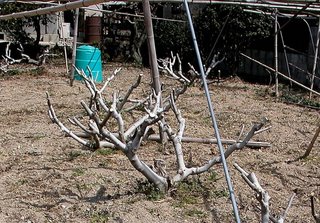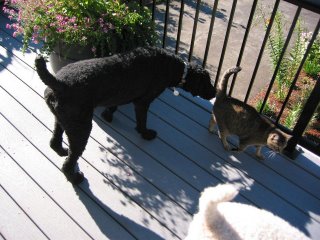Flying to Quincy Illinois for 4 days. Probably can't post (at least, not photos) until return.
Quincy is a historic town, by the Mississippi River. A few interesting things happened there.
It's hot and humid in the summer, cold in the winter. Great tomato growing weather. Rich black loamy soil. Good for apples and corn and soybeans.
Thursday, August 24, 2006
Tuesday, August 22, 2006
Ginkgo Seedling
 Here is a ginkgo seedling that just popped up in the chives last week. The seeds were collected last fall, washed, refridgerated, then planted in various protected spots around the yard. Kind of the "squirrel nut" method. The picture is approximately life size.
Here is a ginkgo seedling that just popped up in the chives last week. The seeds were collected last fall, washed, refridgerated, then planted in various protected spots around the yard. Kind of the "squirrel nut" method. The picture is approximately life size.This is the only one so far this year to sprout. It may have been the mold on the seed hulls (I had hoped that this would help soften the hull, but this was unplanned mold). Last year 7 sprouted, but something ate 4 of the seedling trees during the winter, leaving 3.
There is also a "right way", usually involving storing the seeds in the refridgerator after treating with brief immersion in diluted bleach solution (to kill mold), and nicking or scoring the seeds prior to planting in moist sand or moist paper towels.
Then again, there is the idea of eating, not planting the seeds, referred to as "ginkgo nuts'. I tried a few last fall. Maybe again this year, now that I know more about them.

Sunday, August 20, 2006
The method for growing figs in Japan (with link to original site)
 These photos of pruned, dormant figs are from a web site by Ken Love in 2004. It basically looks like a modified espalier style of pruning the fig trees. He describes the Japanese method as (paraphrased from the linked site):
These photos of pruned, dormant figs are from a web site by Ken Love in 2004. It basically looks like a modified espalier style of pruning the fig trees. He describes the Japanese method as (paraphrased from the linked site):Young trees are grown to about 2 meters tall. They are then gradually lowered to a horizontal position, over a period of about 10 days. These cordons are then tied to horizontal supports, about 40 cm above the ground.

A pair of verticals can be tied in opposite directions; or 4 in an X pattern. The lateral's tips are pruned at a length of 2.5 to 5 meters.
During the dormant season, the vertical branches are pruned to 2 to 3 nodes each. When shoots appear, only the outermost shoot is kept. During Spring, shoots for fig production sprout from the horizonal limbs. These are pruned such that new upright cordons are 30cm to 50 cm apart, with 50 being considered optimal for production. The vertical shoots are tied to supports. Each vertical produces 18 to 20 fruit per season.
There are many more photos on the site; I could not find clear photos of figs in production stage. This looks like a nice method for back-yard production of figs, since it could be applied to a limited space.

Pole ("cordon") method for tomatoes. Works for me.


The first yellow Brandywine is starting to ripen. These tomatoes are so plentiful and heavy that they bent over the steel pole. Better Boys are starting to ripen too.
The cordon (pole) method works best for me here in this climate. I think it's because it allows for maximum sun exposure and keeps the leaves away from the ground and unshaded. I pinch the new branches ('suckers') at one leaf, which some call the Missouri Pruning method.

"Work / Life Balance" (not)
Subscribe to:
Comments (Atom)
